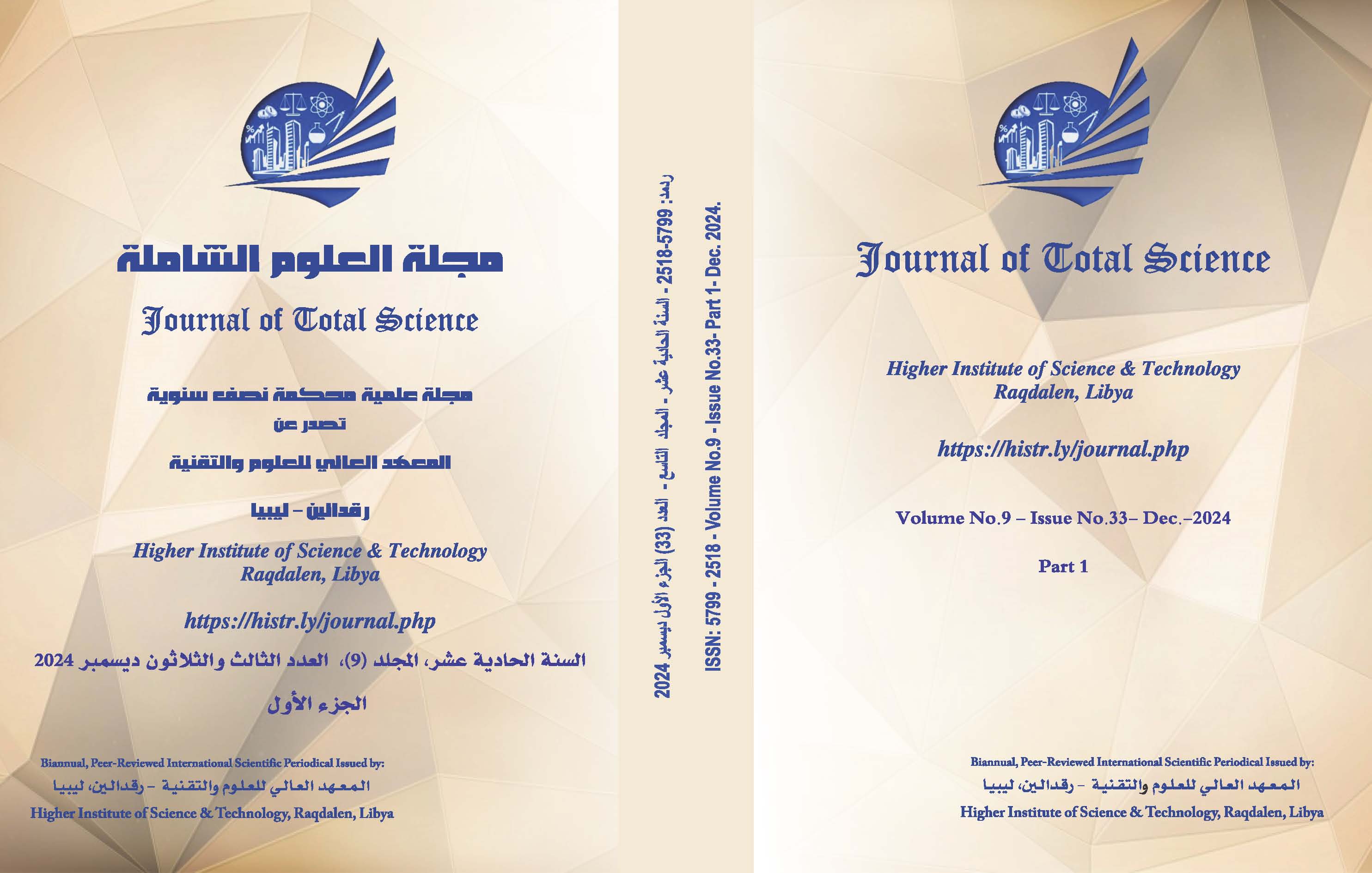GEOCHEMICAL EVALUTION FOR FORMATION WATER OF SOME WELLS IN AMAL OIL FIELD, SIRT BASIN, LIBYA
الكلمات المفتاحية:
Geochemistry، Classification، Amal Field، Oil field Watersالملخص
The present paper deals with classification of oilfield water of Maraghand Amal formations at Amal oil field, concession NC-12 ,in the eastern margin of the Sirt basin, Libya.Ten chemically analyzed water samples from different wells were used in this study; chemical analyses of the major ions of the water samples showed Total Dissolved Solids (TDS) in the ranges from 205487 to 234912mg/l.
The geochemical ratios of Na/Cl, ((Na-Cl)/SO4), and ((Cl-Na)/Mg) were calculated for formation water of ten wells classification following Sulin's (1946), whereindicate that all of these water are Cl-Ca type waters under subsurface conditions; this type reflects isolated waters with hydrostatic conditions.According to Bojarski's (1970), the chloride-calcium type of this water subdivided to chloride-calcium III, which reflects the favorable zone for the preservation of hydrocarbons, followed by chloride-calcium II in other wells.This class reflects the transition zone between active hydrodynamic and stable zones. Graphical methods in water analysis enable efficient pattern comparison for quick identification of differences between water samples.Consequently, both the piper diagram and the stiff diagram were utilized in this study. The piper diagram in this study indicates most of the samples were classified as (Na++K+) and Ca2+ types of cations and Cl- types of anions;then these waters consist of the alkalis that exceed alkaline earths.The Stiff Diagram polygons showed most of the samples reveals similar chemical compositions with high chlorine and sodium levels, followed by magnesium and bicarbonate, while sulfate is low. In contrast, the waters in some wells have higher magnesium concentrations.
التنزيلات
المراجع
Abou El Leil, I.M., and et al., 2022, Classification And Geological Environment Identification Of Produced Water In Oilfields. ISTJ International Science and Technology Journal, vol 30: p.1 -20, (2022). Barkham S., Habesch S., Libya - Concession 12 Amal Field Geological Studies, December 2005, Haruge Unpublished report.
Barr,F.T. and Weagar, A.A., 1972, Stratigraphic nomenclature of the Formation in Sirt Basin: Petroleum Exploration Society of Libya.
Collins, A.G., 1975, Geochemistry of oil –field waters, Amsterdam, Netherlands: Elsevier scientific Publishing.
Dicky, P.A., 1986, Petroleum Development geology: penn well publishing company, Tusa, oklahomausa. Third edition.
Elgariani. N, 2007, Role of Oil Field water geochemistry in hydrocarbon Expolration and production in Nasser field, NC-6, Libya: Unpolished M.SC. Thesis, University Tripoli, Libya.
Geopec, 1994, Amal Field, Final Report.
Jiranek, J., Cartwright, J. and Vejmelek, L., 1998, Fault sealing analysis of a segment of the Outer Moroccan Rifian Fold Belt, northwest Africa. Marine and Petroleum Geology, vol.15(7), pp. 635-649, (1998).
Liu, X., and et al., 2024, Geochemical characteristics and origin of the formation water of the Saline Lake Basin:a case study of the Quaternary Qigequan Formation in the Sanhu Depression, Qaidam Basin: Geoscience Letters., DOI 10.1186/s40562-024-00332-y,(In press).
Mobil, 1979, Amal Field Study Geological Report.
Patton, C. C., 1986, Applied water technology: Campbell petroleum series norman, Oklahoma. Second Edition.
Qader, F.M., and et al., 2021, Geochemical Evaluation Of Formation Water, Mauddud Reservoir, Khabbaz Oilfield, Kirkuk Area, Northern Iraq. UKH Journal of Science and Engineering, vol. 2(5): pp.28 -35, (2021).
Refai, T.R., 2011, produced water management in Libyan oil fields: unpublished report Geological Engineering Department.
Roberts, J. (1970). Amal Field. In: Geology of Giant Oil Fields (ed Halbouty, M.T.). Mem. Am. Assoc. Petrol. Geol., 14, 438-448.
Schlumberger service company,1997 . Unpublished Technical Report.
Whitbread, M.H., 1989, Mesozoic rift-drift sequence of northern Africa and eastern South America.
التنزيلات
منشور
إصدار
القسم
الرخصة

هذا العمل مرخص بموجب Creative Commons Attribution-NonCommercial-ShareAlike 4.0 International License.










